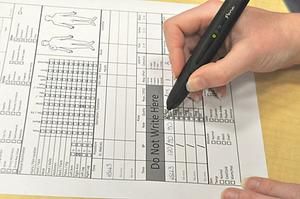SyncPens are the future of JCEMS medical reporting 
Ripley, W.Va. — With calls running in the thousands annually, streamlining the workflow of medical reporting is an ever-present challenge for emergency medical supervisors, said Steve McClure, Jackson County EMS director.
Managing medical reporting, while complying with state mandates, is a challenge that Jackson County Emergency Medical Services, takes seriously, McClure said. In a field where seconds count, every effort is made to ensure that time is used in the best possible manner.
In the last several years, EMS medical reporting has undergone massive changes as technology continues to change and improve. In order to cope with a staggering amount of paperwork flowing into their offices, the statewide system looked to “paperless” electronic reporting, but it now appears that technology may allow a marriage of the two forms. The new system uses an advanced ink pen to fill out paper forms, while also capturing the information digitally (for more on the new technology, see Part II of this series in Thursday’s edition of the Jackson Star-News).
The biggest question is: Which system is most efficient in a field where seconds count? McClure said he fully believes a marriage of paper and digital functionality best fits Jackson County.
“When you’re trying to manage an EMS system or any system, you always have to look at time utilization,” McClure said.
Jackson County EMS currently uses a “paperless” system whereby reports are done on laptops and sent to the state.
Going paperless was a costly endeavor, warranting the purchase of tough laptop computers at $3,000 apiece for installation in local ambulances. The laptops have to be tough in order to withstand the daily use by an active EMS crew, McClure said.
It takes about 15-20 minutes to fill out a medical report using the current laptop-based reporting system, McClure said.
“In July 2009, the state mandated that all EMS agencies in West Virginia go to electronic patient care reports. The state partnered with NC to see how NC went digital. They basically modeled our procedure right off of theirs,” McClure said.
The state provided a free reporting software system for EMS agencies that was adequate but difficult to navigate, McClure said.
“The state, instead of having an unfunded mandate that said you’ve got to go electronic as of this date, they provided a free reporting system. It’s adequate, but it isn’t very user friendly,” McClure said, adding that the clumsy interface increased the time it took to fill out a report.
In addition to equipping trucks with durable laptops and using a free, if slightly flawed reporting system, there was an issue of ensuring that all EMS stations in the county were up-to-date with Internet accessibility.
“I’ve got three stations: one in Kenna, one in Ravenswood and one in Ripley. The only way you can submit electronic patient care reports is electronically. That means you have to have Internet access. I didn’t have that in two out of the three stations,” McClure said.
McClure said he bit the bullet and completed the installation of the laptops in the trucks, established Internet access at the EMS stations and chose to upgrade to a better reporting system in hopes of decreasing the time it took to fill out patient reports.
“We bought our own software reporting system. If you bought a software reporting system, you had to meet certain standards. We met all the standards,” McClure said.
Still, it takes longer to sit down at a laptop and type out a report than it does to fill out a form. In addition, the signatures of nurses, doctors and patients for various digital forms have to be obtained digitally using a stylus and on-screen signatures, which can be clumsy at times, McClure said.
“All my guys still have to sit down and type everything out to enter into these reports,” McClure said.
So, while electronic reporting makes sending information to state officials more efficient, the current method tends to eat up valuable time, McClure said. Every minute spent on reporting is a minute a paramedic or EMT doesn’t have available to answer calls, he said.
The second and final installment of this two-part series, to be published in Thursday’s edition of the Jackson Star-News, will look more at the SyncPen technology that is allowing a “marriage” of paper and electronic reporting.










